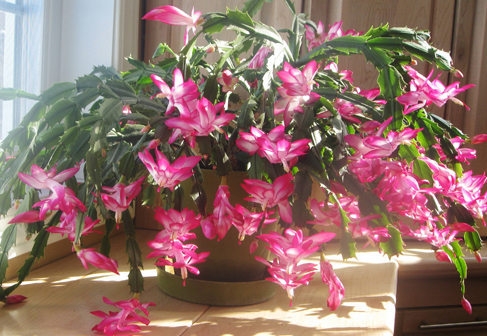
CHRISTMAS CACTUS CARE

Christmas cactus (Schlumbergera bridgesii) is a popular, winter-flowering houseplant native to Brazil, available in a wide variety of colors including red, purple, oranges, pinks and creams. *Christmas cactus is a member of a group sold as holiday cacti that includes the Thanksgiving cactus (Schlumbergera truncata) and the Easter cactus (Rhipsalidopsis gaertneri). When grown under normal night length conditions, Thanksgiving cacti normally flower near Thanksgiving approximately a month before Christmas cacti. The Easter cactus flowers primarily in the spring and sporadically throughout the year. All of the holiday cacti have similar cultural requirements.
CULTURE
Light and Temperature: The Christmas cactus grows best in light shade. Full sunlight is beneficial in midwinter, but bright sun during the summer months can make plants look pale and yellow. Ideal growth occurs at temperatures between 70 to 80 °F during its growing season from April to September. Do not let temperatures rise above 90 °F once the flower buds are set in the fall. Continuous warm temperatures can cause flower buds to drop.
The secret of good flower bud production involves temperature and dark (photoperiod) control. To flower plants need: a) Bright light; b) Night temperatures between 55 and 65 °F and c) Long nights – 3 or more hours continuous darkness each day is required before flowering will occur. Long nights should be started in the middle of September and continued for 8 weeks.
Watering and Fertilizer: Water the growing medium when it is dry to the touch. The Christmas cactus is tolerant of dry, slightly under-watered conditions. Do not let the soil become waterlogged, especially during the dark days of winter. Do not let the soil dry out either. Reduce watering from fall through spring. Fertilize plants monthly from the time new growth starts in late winter or early spring, and throughout the summer using a one-quarter strength soluble fertilizer. Reduce fertilizer during the fall and early winter.
Growing Media: The Christmas cactus flowers best when kept somewhat pot bound. Repotting is necessary only about once in three years. The potting media must be well drained with good aeration, because the Christmas cactus does not grow well in heavy, wet mixes. A good mix may contain one part potting soil, two parts peat moss or compost, and one part sharp sand or perlite.
POTENTIAL PROBLEMS
The Christmas cacti commonly drops unopened flower buds, which may be induced by an excessive number of buds or a sudden change in temperature, light or other environmental factors, such as drying out of the growing medium. Lack of flowering is often due to light interrupting the long night period (13 hours) that is required for flowering initiation to occur. Streetlights, car lights or indoor lighting can disrupt the required dark period. The
major disease is root rot, which can be prevented by avoiding excessive watering. Insects and related pests include mealy bugs, soft brown scale, red spider mites and aphids.

